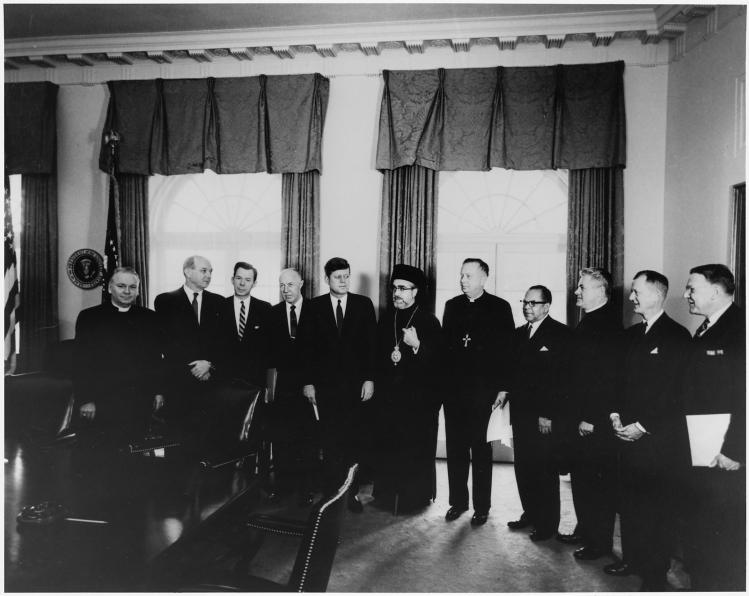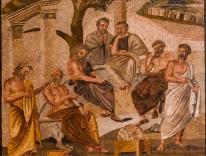
White Christianity is dying in America, leaving its members caught up in various stages of the grieving process. The slow death reflects a profound demographic change over two generations. While nearly seven in ten American seniors describe themselves as white Christians, fewer than three in ten young adults—29 percent—fall under this designation; and so for the first time in our nation’s history, white Christians are a minority, constituting just 46 percent of our overall population, according to the Pew Research Center.
In The End of White Christian America, Robert P. Jones captures people moving from denial to acceptance of the passing of the nation’s long-dominant religious group. How to mourn—and how to go on? The book opens with an obituary for the deceased and an accounting of their remaining assets—including a collection of monumental buildings. The United Methodist Building in Washington, D.C., reflects the death of White Mainline Protestant optimism. For decades its prominent location represented “vested and powerful faith traditions within white Protestant Christianity,” but occupants now represent “a wide array” of religious organizations. The Methodists have rebranded the building as “an inclusive religious voice for justice.” In Southern California, the Crystal Cathedral—bankrupt in 2010, sold two years later—embodies the recent struggles of White Evangelical Protestantism. And the imposing Interchurch Center on Riverside Drive in New York City, dedicated by President Dwight Eisenhower in 1959, and a place where many major Christian organizations once shared tenancy, represents the lost fervor of mid-twentieth-century Christian ecumenism. Jones takes the 2013 departure of the National Council of Churches from its spacious offices in the building as symbolic of his narrative of decline. (He neglects to mention the somewhat less spacious offices Commonweal has occupied there since 1997.)
Jones’s narrative of decline, principally of white mainline Protestants and white Evangelicals, is capably told and bolstered by plentiful sociological data, especially from the Public Religion Research Institute (of which he is the CEO). The book’s most original and compelling contribution comes in its final analysis, “A Eulogy for White Christian America,” which serves as a timely reflection on the classic “stages of grief” popularized by Elisabeth Kübler-Ross, and constitutes an artful and accessible psychoanalysis of contemporary American Christianity. Jones uses the tenures of two successive leaders of the Southern Baptist Convention’s Ethics and Religious Liberty Commission, the hard-liner Richard Land (1988–2013) and the more accommodating Russell Moore (2013–present), to frame the stages of grief. There are others he could have picked for the role of “denier-in-chief” concerning the state of American Christianity—Ralph Reed and Mike Huckabee come to mind—but Land practiced “a particularly extreme form of denial,” countering the statistical reality of decline with deflection and nostalgia.
As Kübler-Ross noted, denial in the face of death often leads to anger—a mode that “comes naturally to white evangelicals,” Jones asserts, who “have developed a rich lexicon of apocalyptic anger...and nostalgic ‘re-’ words like ‘reclaim,’ ‘restore,’ ‘renew,’ ‘repent,’ and ‘revive.’” But Jones may have written his book a few months too soon to catch the apotheosis of White Protestant anger. The campaign of President Donald Trump whipped up new levels of rage among some white Christians, who grieved their loss of power in ritual displays of group bellicosity at Trump rallies around the country. About those in grief, Kübler-Ross described “anger displaced in all directions and projected onto the environment at times almost at random.” Whether about the raucous cries of “Lock her up!” or the assaults on hecklers, that could be an apt description of many a Trump rally.
On Election Day many channeled that anger into action, as white Christians—both Protestants and Catholics—made Trump’s election possible. Low voter turnout overall enabled this shrinking but still large demographic, backed into the corner of a culture war, to voice one more shout of denial. As the votes rolled in on election night, Jones tweeted out a map of white Protestant demographics that was eerily similar to Trump’s emerging path to victory. Then white Catholic voters in Pennsylvania, Michigan, and Wisconsin pushed the white Protestant plurality states over the electoral edge. Perhaps ecumenism is not over, after all.
Bargaining is the third stage of grief, and it, too, helps to illuminate recent events. Jones isolates an example elegant in its simplicity. In 2015, members of the Mississippi House of Representatives sponsored a bill to designate the Bible as the official state book—a blatant effort, Jones writes, “to prop up a dying White Christian cultural consensus with the force of law.” While the bill failed to make it out of committee, the effort symbolized a psychological truth—namely, that “when leaders feel it is necessary to state explicitly what has always been assumed, they betray their own cultural insecurity.”
We’ve seen a more complex form of bargaining amid grief during the conflict between civil rights for LGBT citizens and religious accommodations for those objecting to such rights. For example, two years ago New York Times columnist Ross Douthat wrote a widely discussed column, titled “The Terms of Our Surrender,” expressing longing for a negotiation in the culture wars, one that might preserve the possibility for religious dissent. Seeing the hope for such a bargaining opportunity slipping away, Douthat moved toward depression and acceptance: “We are not really having an argument about same-sex marriage anymore, and...we’re not having a negotiation. Instead, all that’s left is the timing of the final victory—and for the defeated to find out what settlement the victors will impose.”
Examples of depression, or perhaps “preparatory depression,” in the face of White Christian America’s death were signaled decades ago by the Methodist theologian Stanley Hauerwas for mainline Protestants (Resident Aliens), and more recently by the late David Kuo for evangelicals (Tempting Faith). A current case would be Rod Dreher. A prominent blogger for The American Conservative and author of several popular books, Dreher has gone through the stages of grief in real time and on public display. He seems to be transitioning from “depression and disillusionment” toward acceptance, via the radical “Benedict Option” movement.
Among those who have accepted the death without advocating this kind of retrenchment and isolation, Jones rightly singles out Russell Moore, whose 2015 book, Onward, captures the spirit perfectly with its blank admission that “it is no longer possible to pretend that we are a Moral Majority.” Though Jones has some critical words for Moore, the Southern Baptist leader has nonetheless offered a new hope for Southern Christians to engage White Christian America’s racist history, especially by taking the Black Lives Matter movement seriously and by inveighing against the public display of the Confederate flag. “The cross and the Confederate flag cannot co-exist without one setting the other on fire,” Moore has written. “White Christians, let’s listen to our African-American brothers and sisters.... Let’s take down that flag.” Such leadership veers sharply away from the tone of his predecessor, Richard Land, who was fired from his radio show for callousness about race in the wake of the Trayvon Martin shooting.
If White Christian America is indeed to go “onward,” it needs to dampen nostalgia, overcome fear and anger, and accept a different role in a diverse country. The only way forward is “a different social arrangement,” Jones writes, “in which white evangelical and white Mainline Protestants find their seats at the table alongside Catholics, Jews, Muslims, Hindus, Buddhists, and the religiously unaffiliated.” Of course, White Christian America has sought and sponsored this kind of ecumenism before, inviting sundry parties to gather round sundry religious tables. The difference this time is that the tables—and the buildings—are no longer theirs. “This time,” Robert P. Jones comments, “they will be guests rather than hosts.”
The End of White Christian America
Robert P. Jones
Simon & Schuster, $28, 320 pp.
Please email comments to [email protected] and join the conversation on our Facebook page.
Share
Previous Story
When Trump Meets Francis
Next Story
A Budget Banking on Trump’s Lies

